Recipe for Tajarin Pasta With Beef Ragu
Tajarin Pasta with Brown Butter Sage Sauce
Discover the Quintessence of Pasta in Piedmont
by Cecilia Puca
Recipe by Chef Abram
If you are looking for a transcendent pasta experience, I highly recommend you visit Piedmont. This is definitely the region where you can find your pasta nirvana. Piedmont is a gastronomic paradise! In fact, when it comes to luxury food, the homeland of Eataly and Slow Food, Piedmont is one of the Italian flagships.
The region offers such a huge variety of wonderful traditional dishes to try that you don't even know where to start. Well, I would start with pasta, if I were you, which is one of a kind in the area. More specifically, I would start with the iconic Tajarin: the essential pasta made in Piedmont that looks like the more famous spaghetti.
TAJARIN AND SPAGHETTI: ALL PASTAS ARE NOT ALIKE
Tajarin, Piedmontese dialect for Tagliolini or Tagliarini, is the thinnest and richest pasta of the land. It belongs to the millennial family of Spaghetti, like any other shape of long pasta. There are, however, significant differences between the famous Italian noodles and the tajarin. Spaghetti represents the Italian food culture in all the world, for starters. The whole of Italy has been metaphorically incorporated in this timeless delicious food typical of Southern Italy.
Tajarin, in contrast, is more modest, yet not less fierce! It proudly represents the area where tajarin was born: the beautiful Langhe region in Southern Piedmont, which is the homeland of Barolo, Barbaresco and fine white truffles, among other things. As a matter of fact, tajarin was in the farmhouses of the Langhe and Monferrato where it first appeared more than six centuries ago.
Another significant difference is that spaghetti is only made of durum wheat, semolina and water. It is considered to be a poor pasta, yet it is the Italian Pasta Diva in the world without any doubt (together with its sister, pizza, of course). Tajarin, in contrast, is the richest egg pasta of Piedmont and an expression of the very local culture, traditions and identity. Tajarin is the Pasta Queen of the region.
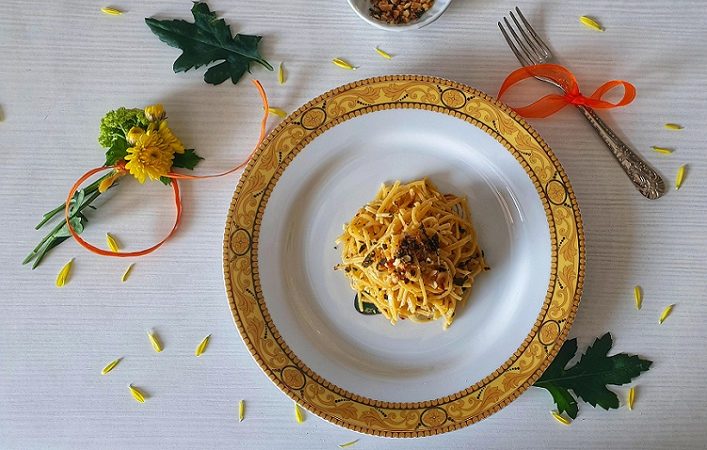
One of the original recipes called for between 30 and 40 egg yolks (yes, from 30 to 40!) to one kilo of flour. Thanks to this feature, tajarin became the typical Sunday dish par excellence in Piedmont, the best recipe to make for important celebrations, especially considering the high price of eggs throughout most of modern history. This aspect impels us to reflect upon the greater prosperity and better living conditions in some areas of Italy's boot, especially in the Northern regions of Italy, where the ingredients used in local pasta tell of their level of wellbeing. Another characteristic of tajarin pasta is it being very thin and just a bit longer than regular spaghetti.
TAJARIN: LET'S FIND OUT MORE ABOUT THIS TANTALIZING HANDMADE PASTA
Tajarin pasta is made only with egg yolks, using a very high ratio of yolks to flour (between 30 to 40 egg yolks to one kilo flour). The fresh egg pasta must be rolled out very thinly using a rolling pin and cut into strips with a maximum width of two millimetres using a knife.
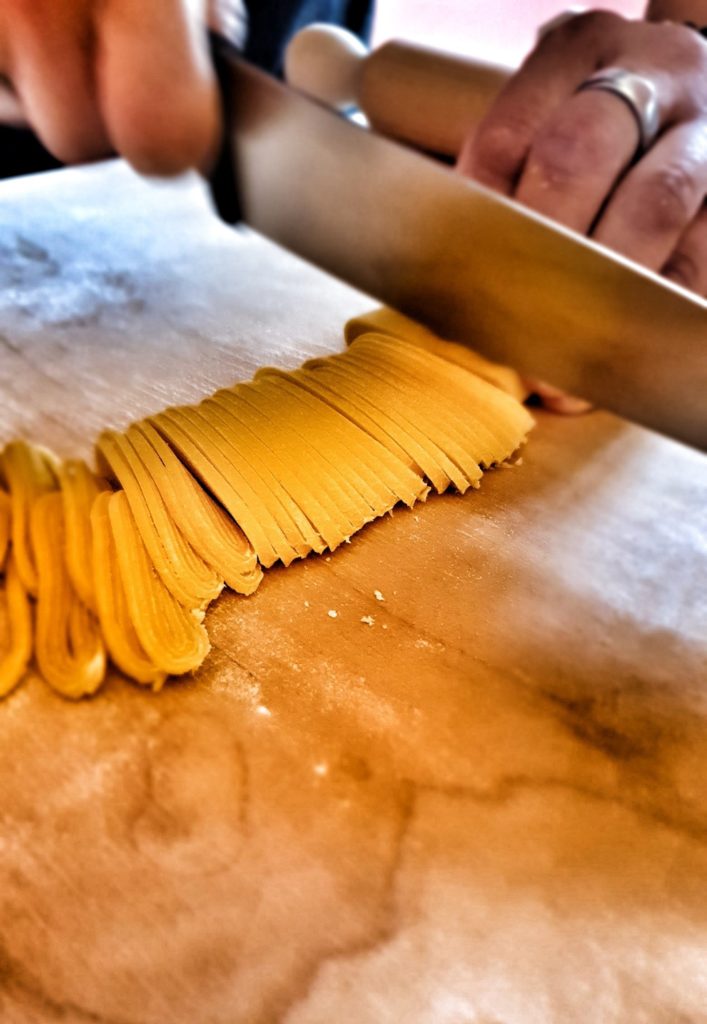
If you really want to taste the tradition that runs into this pasta shape, then you should try to make it rigorously by hand, as the Italian Nonne (Grandmothers) have always done in the past. Although a legend exists (supported in part by Paolo Monelli – one of the greatest twentieth-century gourmet and wine writers) saying that women were capable of making the best tajarin by using their bottoms to roll the pasta sheets out before slicing them, a long time ago…no rolling pin needed, apparently.
This would seem to align with the age-old adage that the best way to gauge the readiness of a pasta sheet is to determine whether or not it is as soft as a baby's bottom . However, whether it is for their delicacy, that comes from being cut into strands from 1/5 to ¼ inch wide, or for the elegant golden color which gives it a unique touch of elegance, tajarin pasta seems to be the favourite traditional pasta dish for Piedmontesi. Try asking them what's the first memory they have about their legendary food. They will probably tell you they started to have a love affair with tajarin immediately after they stopped drinking their mother's milk! And someone else had a love affair with this royal dish…
A DISH DEAR TO THE FIRST KING OF ITALY
Evidently, King Victor Emmanuel II, a well-known gourmet, couldn't resist the goodness of Piedmontese cuisine. There was a woman who conquered the royal palate of the first King of Italy even before his heart…her name was Rosa Vercellana, also known as La Bella Rosina. Before becoming his morganatic wife, Rosa was the unofficial cook for King Victor Emmanuel, who had a soft spot for her delicious handmade tajarin with comodino.
THE VALUE OF TRADITION
Piedmont embodies a philosophy of seasonality, warm hospitality and devotion to tradition. Nonne are custodians of culinary rituals, gatekeepers of millennial recipes and ancient techniques that they have passed down to their children and grandchildren. They keep alive family stories and memories through dishes they have been preparing always the same way, generation after generation, always with the same sacral respect like you were reciting a prayer.
FOOD IS A SORT OF RELIGION
Food is comforting, it has the power of bringing people together, it gives you a sense of belonging, it tells a story about communities' roots, about ancestors. We live in a fashion world where everything has to be glamorous and trendy. But trends come and go. We need to grasp to something that stays. The local food heritage has to be preserved.
The art of making handmade pasta, especially, is becoming increasingly rare. The young generations, and the food, communication and tourism experts, have the social responsibility to keep our priceless intangible culture heritage alive and to share it with the world, without forgetting the importance of looking into the future and responding to the modern necessities, of course. As the ancient Latins have taught us, Innovare Serbando is a great motto in this case.
That's what Abram and I have been doing for almost three years, when we founded our culinary events company in Turin. And this is what our international guests do love the most when they join our food experiences and cooking classes. What's their favourite food in Piedmont? Its traditional pasta, of course! Speaking of which, it's now time to share with you the recipe of handmade Tajarin prepared by Chef Abram, dressed with brown butter sage and roasted hazelnut garnish.
This recipe follows the traditional one which calls for 30 red egg yolks (rossi d'uovo-tuorli) to 1 kilo flour. Eggs with red yolks come from chickens fed a special diet that, among other things, can include red peppers, paprika and annatto seeds.
HOW TO MAKE TAJARIN
EQUIPMENT:
Wooden table or another suitable worktop;
Rolling pin;
Large knife;
Fork;
Dish towel
INGREDIENTS FOR THE PASTA DOUGH (4 Servings):
250 gr 00 flour;
8 red egg yolks (if you can't find red yolks, substitute with normal high quality eggs);
1 teaspoon Evo;
1 pinch of salt
METHOD:
– Put the flour on the work top, make a well in the middle and break the 8 red eggs into it.
– Add a pinch of salt, 5ml (1 teaspoon) oil and knead until it becomes a firm dough.
If you're a beginner, you may have to knead the pasta dough for about 40/50 minutes before having the right mixture;
This recipe, due to the high ratio of egg yolks, requires strength and perseverance; t he more you practice, the easier it will become.
– Rub the surface with oil and let the pasta ball stand for 2 hours;
– Knead the pasta ball again and then roll it out into a thin sheet;
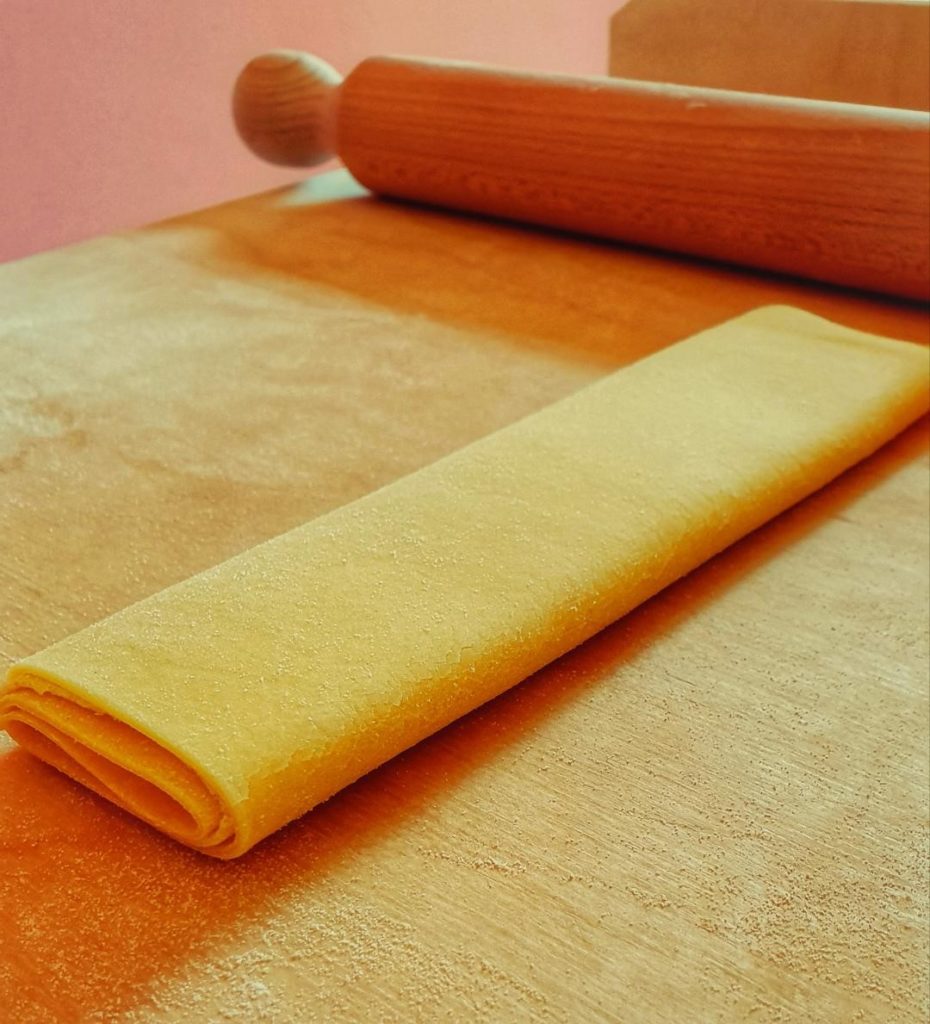
– Let it stand for a few minutes then roll it up and slice it into very thin ribbons;

– Unroll the strips and place them on a dish towel to dry;
– Cook the tajarin in boiling salted water for not longer than 2 or 3 minutes;
Serve with the brown butter sage sauce (recipe follows)
INGREDIENTS FOR THE BROWN BUTTER SAGE SAUCE:
100 gr Alpine butter;
Small pack of Sage, leaves picked;
½ Lemon Juice and Lemon Zest;
Hazelnuts;
Grated Parmesan Cheese;
METHOD:
– Melt the butter over medium heat in a pan with a light-colored bottom, if possible, so you can see the butter goes from white, to gold, to brown ("noisette");
– Add the sage and season with some salt and pepper;
– Cook very briefly until the sage becomes crispy;
– Remove the sage and let it dry on kitchen paper;
-In a small skillet, roast the hazelnuts with 1 teaspoon of oil until they become golden brown;
– Season them with salt and pepper and let them dry on kitchen paper;
When the tajarin is cooked, lift them from the pot with a slotted spoon and add them to the pan;
Add a little of the cooking water to lighten up the sauce and sprinkle some lemon zest over the Tajarin;
Toss very gently to coat, let the sauce becomes one with pasta;
Add half a lemon, juiced;
Serve them warm with hazelnuts, sage garnish and Parmesan.
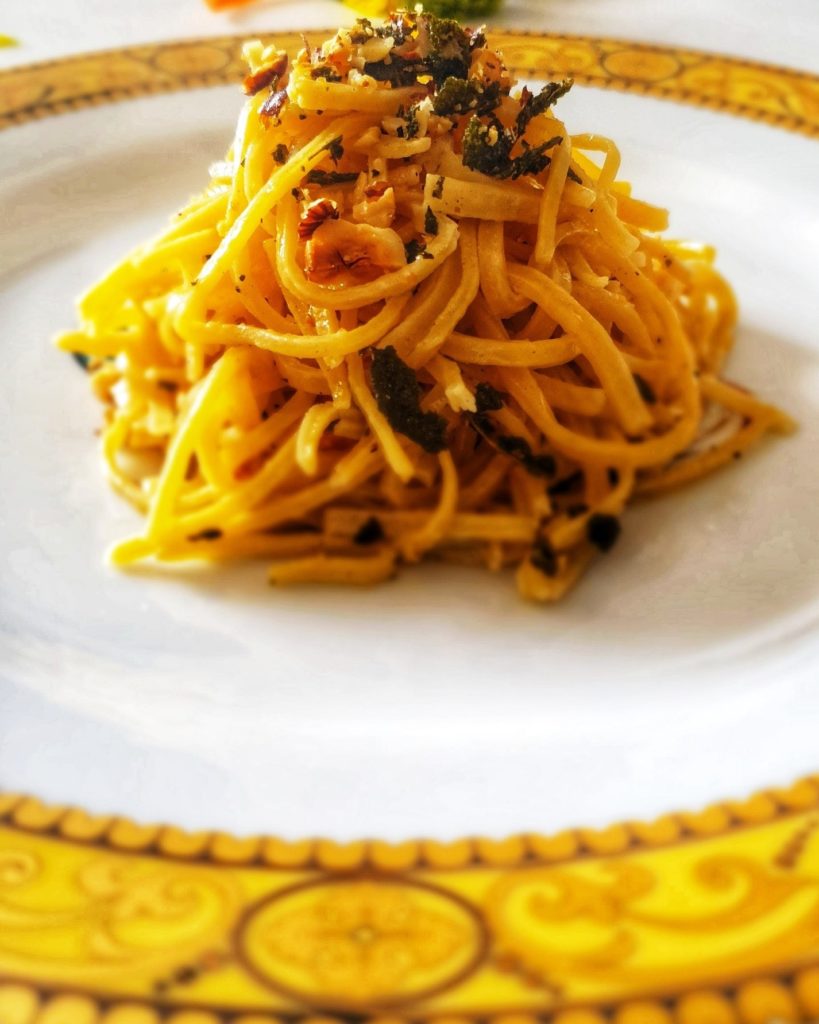
THE FINAL PLATING
For the final plating of this recipe we have chosen a special collection plate with a gold trim.
We thought this could give even more emphasis to a dish that contains the value of the most ancient Piemontese tradition. Which, at the same time, offers elegance and refinement, features typical of Renaissance Cuisine where the thinness of the pasta was synonymous with perfect beauty.
Buon Appetito!
Food and traditions are like gold and this Tajarin dish helps to remind us of that. We hope you've enjoyed learning about Tajarin, its tradition and recipe. Come visit Piedmont for a real taste of deliciousness!
Tajarin Pasta Recipe & Blog Post by Cecilia & Chef Abram. About the Authors:

Cecilia is a Sociologist, Social Researcher, Story Teller and expert in food and cultural events.
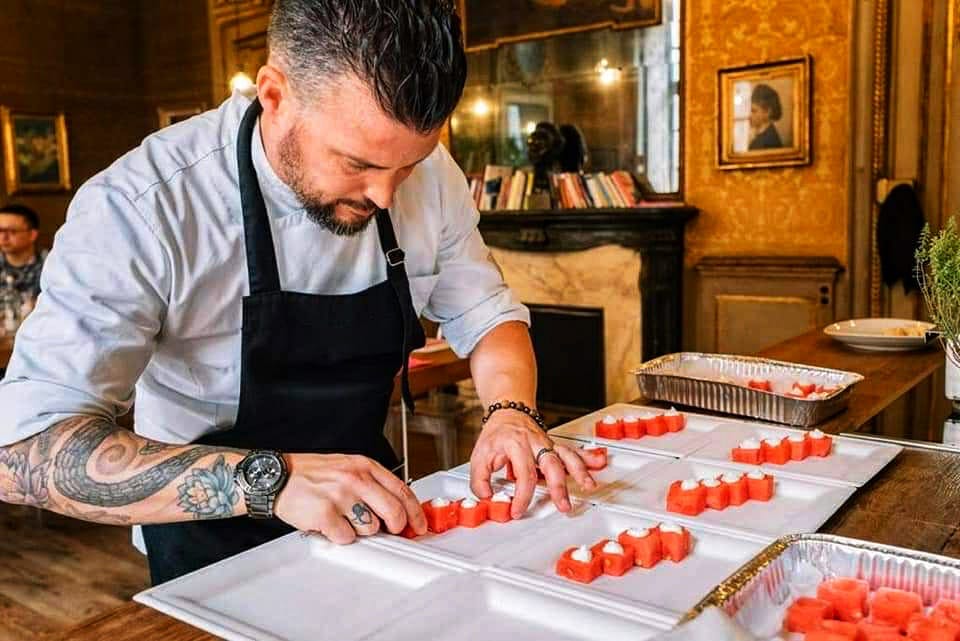
Abram is a professional Chef and Culinary Consultant with more than 20 years of experience in the finest restaurants of Benelux and Northern Italy and worked as a Chef at the prestigious Farmacia Del Cambio in Turin.
Source: http://www.turinitalyguide.com/tajarin-classic-piedmont-recipe/
0 Response to "Recipe for Tajarin Pasta With Beef Ragu"
Post a Comment